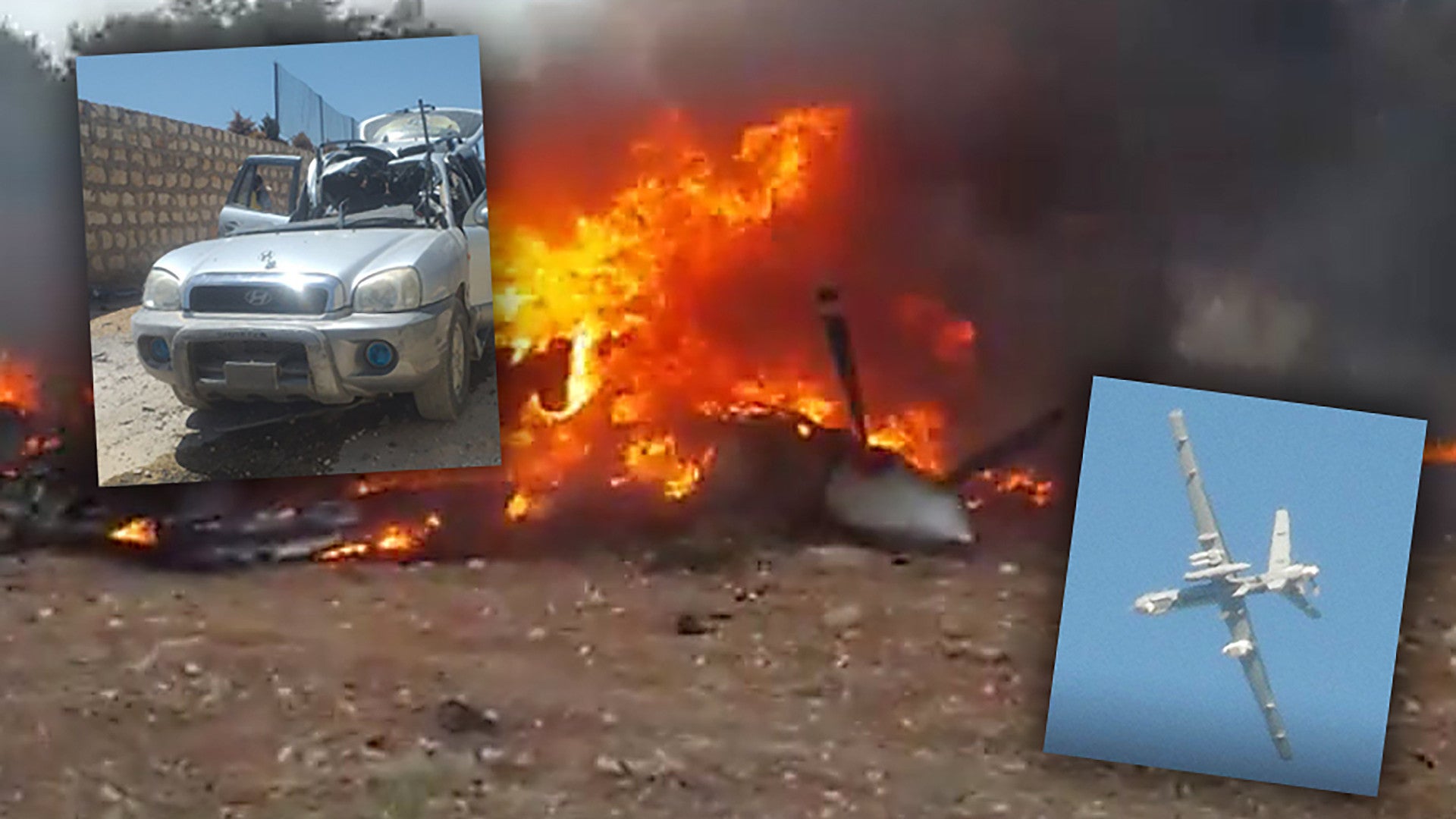Two U.S. MQ-9 Reaper drones reportedly collided in Syria today, but may also have been engaged by militants on the ground. The incident comes after a number of curiously configured Reapers have been spotted in the skies above the country’s western Idlib province in the past few days and the latest strike in that region involving an AGM-114R9X missile. This secretive version of the Hellfire missile uses an array of six sword-like blades that pop out of its body instead of a traditional high-explosive warhead.
Military Times was first to report on the apparent aerial collision on Aug. 18, 2020. “Whether they were shot at afterwards – and whether that caused the crash – is unclear,” that story added.
Earlier in the day, reports had emerged that militant groups in Idlib opposed to Syrian dictator Bashar Al Assad had shot down two drones, possibly belonging to Russia. However, subsequent pictures and videos that appeared on social media suggested that at least one of these downed unmanned aircraft might have been an MQ-9. We have reached out to the U.S. military to try to get further confirmation about the loss of the Reapers.

Various factions in Idlib, including those that Turkey actively supports, do have access to shoulder-fired surface-to-air missiles, also known as man-portable air-defense systems (MANPADS), and have used them to shoot down manned aircraft and helicopters in the past. It’s not clear why anti-Assad groups would necessarily have targeted drones that might be belonged to the United States, but if this was the case, they may simply have had no way of telling who the operator was and thought they were flown by Russians or other pro-Assad forces.
We do know that Reapers have been particularly active over Idlib recently. Radio Fresh FM, an independent radio station in Idlib, which is not presently under the complete control of the regime of Syrian dictator Bashar Al Assad, posted a set of pictures reportedly of three different MQ-9s over Idlib on Aug. 14, which was followed by another group of images showing at least two different Reapers on Aug. 17.
This activity followed the death of Abu Yahya al-Uzbeki, a “military trainer,” who had been most recently working for the terrorist group Hurras al-Din, also known as Al Qaeda in Syria, on Aug. 12. He had died when his Hyundai SUV was hit with what appears to have been an AGM-114R9X while he was driving in Idlib. The U.S. military has targeted this group before and employed this shadowy missile, also referred to as the “ninja bomb” and “the flying Ginsu,” against senior members in the past.
Al-Uzbeki’s vehicle showed the telltale signs of an AGM-114R9X impact, most notably the characteristic cut marks in the roof. Much of the front and the rear of the vehicle sustained limited damage, underscoring just how precise this weapon is and how little collateral damage it causes. You can read more about what we have been able to glean about this weapon in greater detail in these past War Zone pieces.
We don’t know for sure if any of the MQ-9s photographed flying over the region in the aftermath of the strike were related to it in any way. However, they all have distinctly atypical configurations and stores loadouts compared to the Reapers commonly seen in U.S. military images and video. More routine loadouts for these drones consist of a mix of Hellfire missiles, precision-guided bombs, and external fuel tanks on their four underwing pylons.
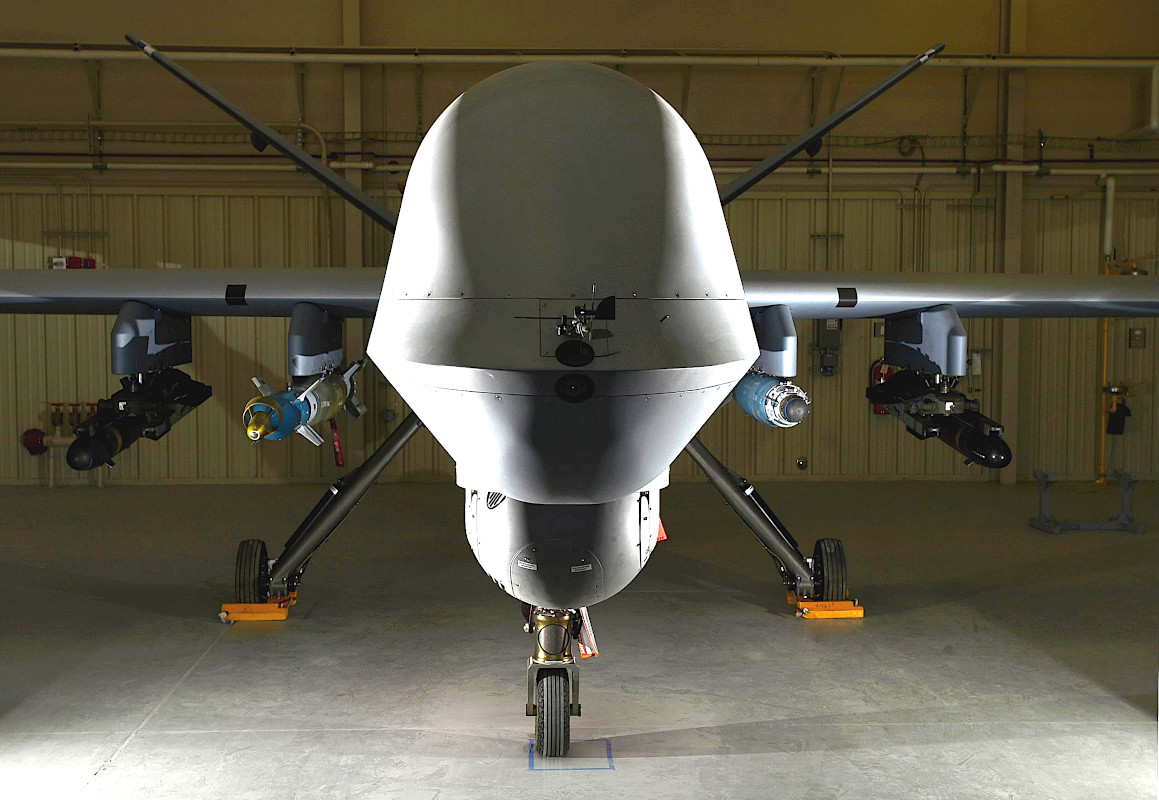
One of the drones seen on Aug. 17 – the first in the series in the Facebook post below – is carrying four missiles, in two pairs of two. What’s interesting is that these missiles appear to be primarily gray-colored, rather than charcoal-black. The base color of all Hellfires, including the AGM-114R9X, is black.
This raises the possibility that this Reaper may be carrying a load of new AGM-179A Joint Air-to-Ground Missiles (JAGM). These missiles have been seen at least on display with gray-colored bodies and entered low-rate initial production in 2018.
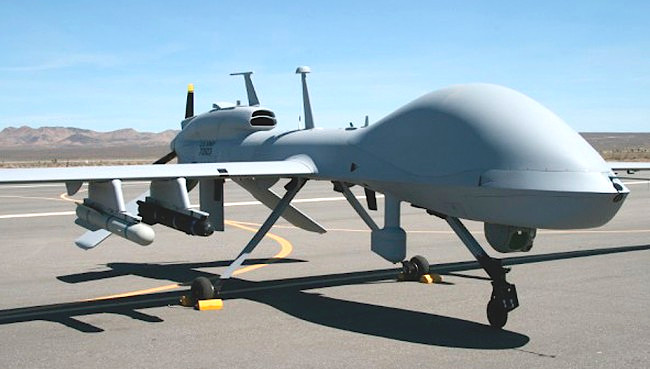
Lockheed Martin’s JAGM is derived from the AGM-114R Hellfire II variant and leverages much of the rear end of that missile, combining it with a new multi-mode guidance section. As such, it is also compatible with any existing Hellfire II launcher, such as those used on MQ-9 Reapers.
Most Hellfires are laser-guided, though the AGM-114L Longbow variant uses a millimeter-wave radar guidance system instead. The AGM-179A has both laser and millimeter-wave radar guidance modes, making it much more flexible in poor weather or in the presence of other atmospheric obscurants. It can also be employed using a much wider range of tactics and it doesn’t necessarily require a laser to be placed on the target in order to home in on it.
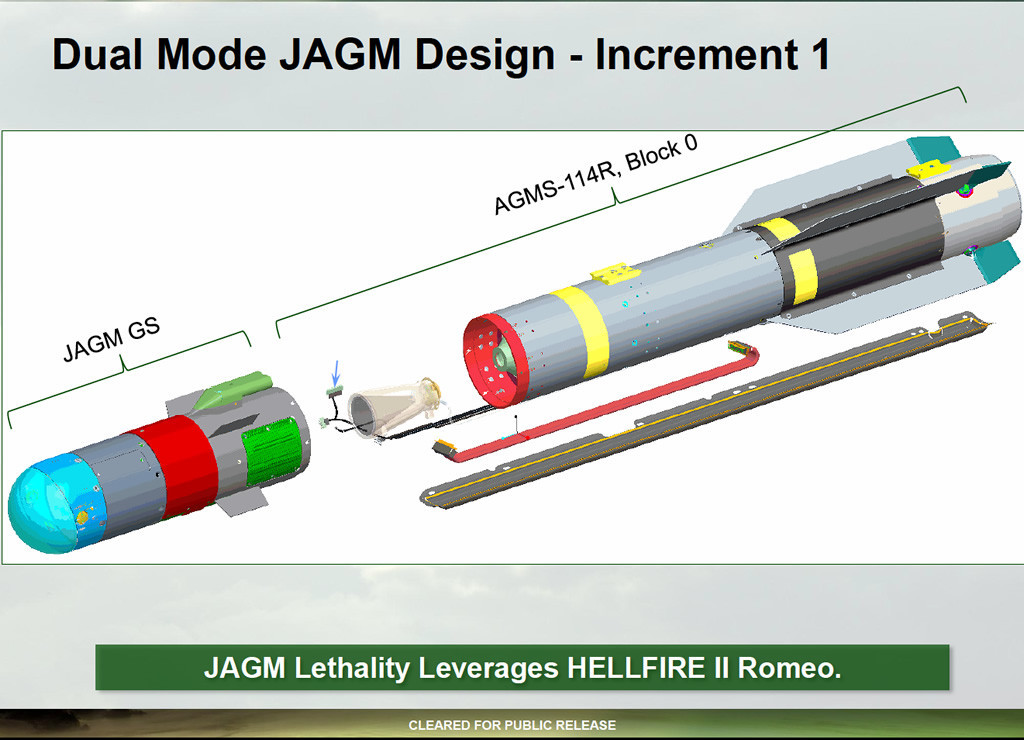
There were unconfirmed reports that JAGMs might have been used in the strike that killed then-commander of Iran’s Islamic Revolutionary Guard Corps Qassem Soleimani in Baghdad, Iraq, on Jan. 3, 2020. This was based on a fragment of a munition recovered afterward that had the marking “WT [weight]: 52.0 kg / 115 lb.” With the exception of the AGM-114K variant, the weight of all Hellfire II missiles presently in service, as well as the millimeter-wave radar-guided AGM-114L, is 49 kilograms, or around 108 pounds. The U.S. Army, which manages the Hellfire and JAGM programs, did not respond to The War Zone‘s inquiries at the time about whether the AGM-179A had been employed in combat.
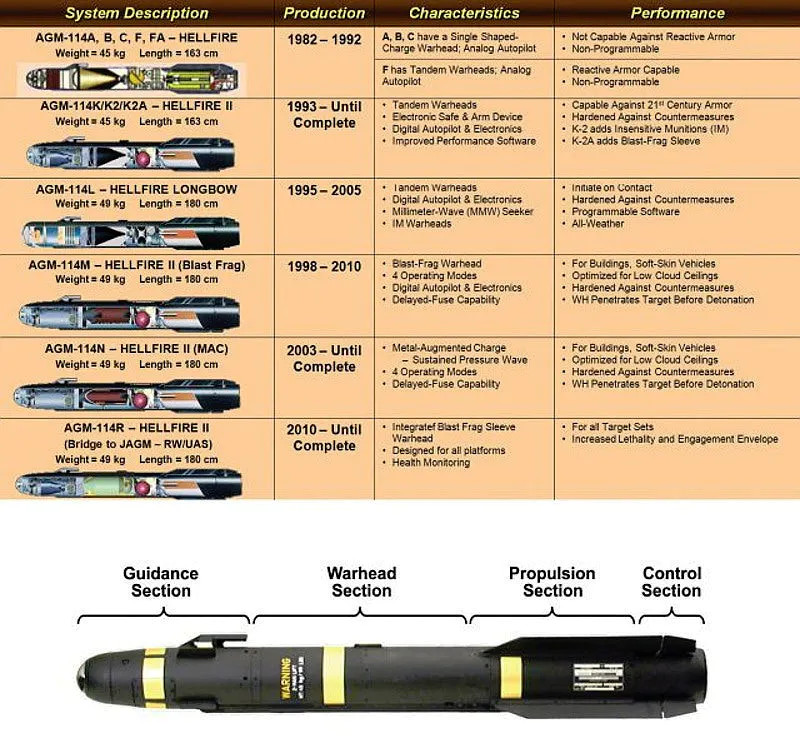
That being said, the fragment reportedly recovered in Baghdad was black colored. Pictures of JAGMs from recent U.S. Army tests also show the missile with a paint job more similar to that of the Hellfire.
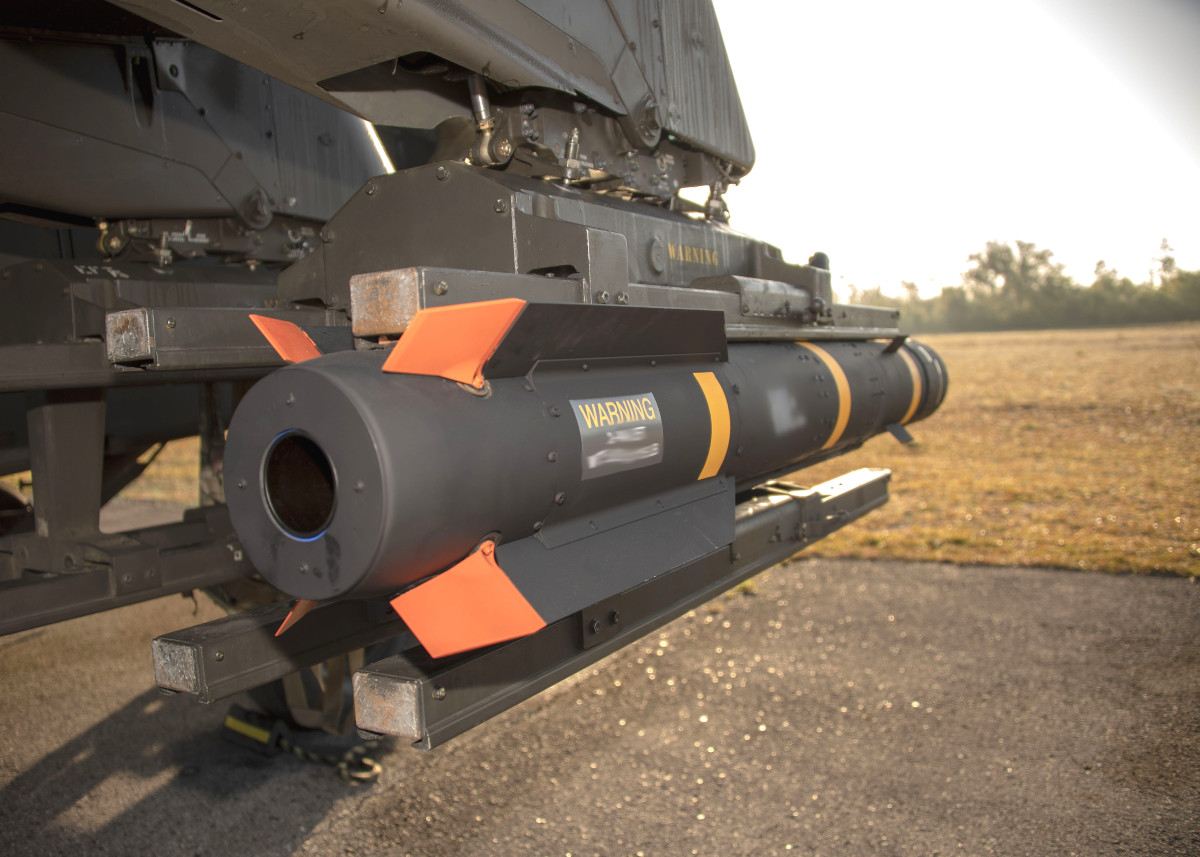
Beyond the missiles, this drone is also carrying a range-extending fuel tank and an unknown pod. The latter store appears to be one of a number of beyond-line-of-sight data link or communications relay pods that have been developed for the MQ-9, as well as the preceding MQ-1 Predator, over the years. These pods are also associated with systems capable of detecting and geo-locating enemy radio, cell phone, and other communication systems. The United States has often used signals from specific cell phones as a key method of locating and targeting specific terrorists and militants.
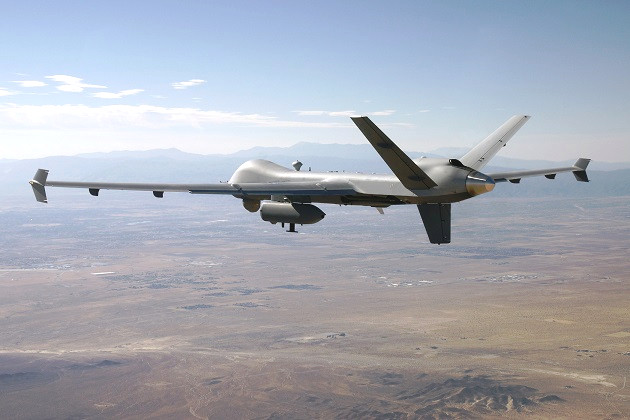
This particular MQ-9 also has a very large blade antenna mounted on the bottom of the rear fuselage. Blade-type antennas are commonly associated with high-frequency radio communications, but they can also support radio direction finding systems, which would also help the drone’s controllers find their target. Last year, the U.S. Air Force actually released a picture of a Reaper at Ali Al Salem Air Base in Kuwait fitted with this antenna, but otherwise with a much more common loadout of two Hellfires and a pair of external fuel tanks.

Another MQ-9 that Salah Jaar photographed flying over Idlib yesterday has a similar configuration to the first one, but is only carrying two missiles instead of four. It is unclear if this is another drone or if the picture may show the previously seen Reaper after it conducted a strike.
The last picture in that series shows a drone with two empty twin missile rails and a fuel tank, as well as a much larger pod with squared-off edges. It also appears to have the large ventral antenna. It’s unclear what the pod’s purpose is, but it could be another type of data-link or a sensor system, such as a small radar with a synthetic aperture imaging capability.
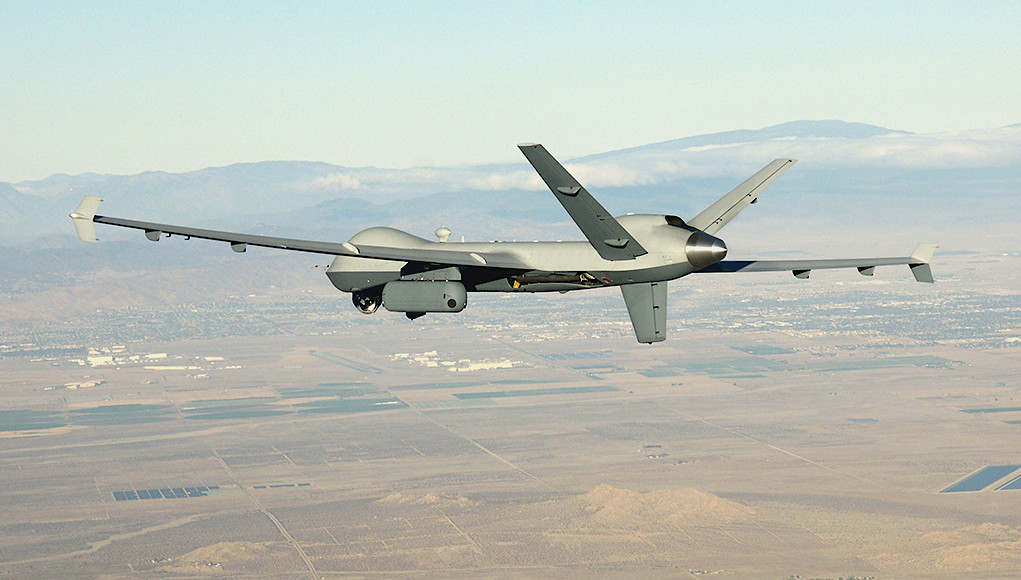
Another possibility is that this could be some sort of self-defense system. It is well known that the Reapers are increasingly vulnerable to both surface-to-air and air-to-air threats and there have been various efforts over the years to develop ways to mitigate those risks, including arming the drones with AIM-9X Sidewinder missiles and adding podded radar warning receivers to the loadout. As noted earlier, there are significant air defense threats in Idlib, including from non-state actors, that have generally made it a no-go zone for non-stealthy manned aircraft from the U.S.-led coalition fighting ISIS in Syria and Iraq under most circumstances.
Whatever this system might be, images reportedly of wreckage from one of the drones that went down in Idlib include one that shows the remains of a long pod that looks very similar in size and shape.
The images captured on Aug. 14, the day after the apparent AGM-114R9X strike on Abu Yahya al-Uzbeki, show two more Reapers with combinations of missiles, fuel tanks, and pods, as well as the large antennas under the rear fuselage. The set also has a picture of a third MQ-9 that looks to be configured as a sensor or data-relay truck with no less than three of the smaller pods, as well as the longer, square-ish pod and a fuel tank. There are no munitions visible at all.
Reapers with similarly unusual configurations have been spotted flying over Idlib in the wake of AGM-114R9X strikes in the past, as well. The War Zone’s own Tyler Rogoway has previously highlighted how that missile may require a man-in-the-loop guidance system to hit its target with such reliable precision, something that could easily require additional data links, writing:
“Most variants of AGM-114 Hellfire missiles use semi-active laser guidance where the seeker on the missile homes in on a laser spot being emitted from an aircraft overhead or by operatives on the ground. It is highly accurate for a weapon that is packed with high explosives. But in the case of the AGM-119R9X, which has no area blast effects at all, it has hit all three targets we have evidence of perfectly in the exact same spot and angle. This begs the question, does this weapon have man-in-the-loop guidance in which a person literally flies the missile into a precise point on the target via command data-link?”
“Israel, in particular, has perfected this method of smart weapons delivery and uses it on many disparate weapons in their inventory. On the other hand, maybe new high definition optics and lasers and a very sensitive seeker head are being used to place the weapon more accurately using a traditional laser-guided weapon concept of delivery? Or maybe something else going on here. We just don’t know. But considering the missile, which is roughly three and a half feet wide when its blades are extended, has perfectly nailed its target every time we know of and in the same exact spot, some sort of extremely accurate guidance is definitely being used. “
…
“A particular MQ-9 [seen below] has been repeatedly spotted high over Aleppo in recent days, which is not unusual. But what is unusual is its loadout. It appears to carry two data-link pods, four Hellfire derivatives, and an external fuel tank. This would make sense. One pod would link with the missile in-flight for man-in-the-loop control while the other would link with a controller of that missile. Executing a man-in-the-loop weapons engagement via the Reaper’s satellite data-link may be troublesome. As such, the Reaper would act as a surveillance and launch platform, with the missile guidance being carried out by another party. The other pod would handle this data-exchange.”
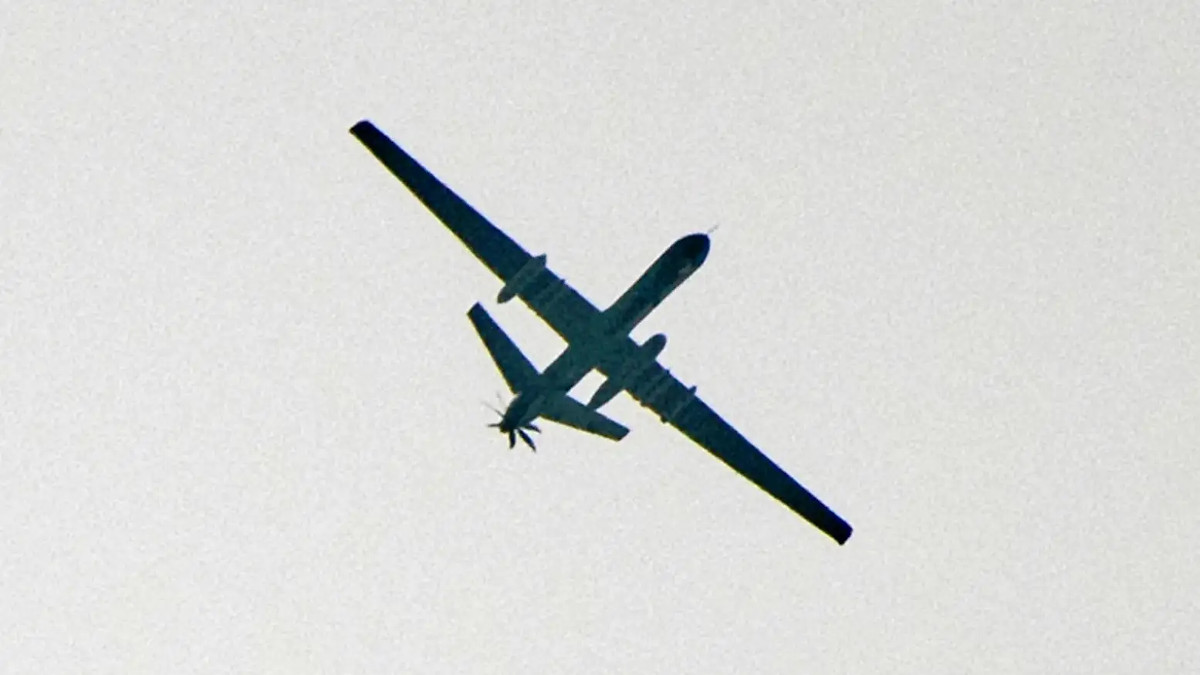
The Reaper in the picture above, shot in Idlib in 2019, also appears to show a drone with a six-bladed rear propeller that had not been previously seen. It remains unclear if this was a camera aberration or not, but it was visible in all the other photographs taken of this drone that day, which included shots from multiple angles.
However, while standard MQ-9s have three-bladed props, some, such as the example seen in Kuwait with the large ventral antenna, are now equipped with four-bladed types that help improve performance and fuel efficiency, as well as make the drone quieter. The latter benefit of a multi-blade propeller would be especially valuable for persistent surveillance and strike missions to reduce the chance of alerting the target. Reapers operated by the Central Intelligence Agency (CIA) were reportedly among the first to receive the four-bladed units and could now have even more advanced propellers installed. Other secretive organizations, such as the U.S. military’s Joint Special Operations Command (JSOC), could easily have followed suit, as well.
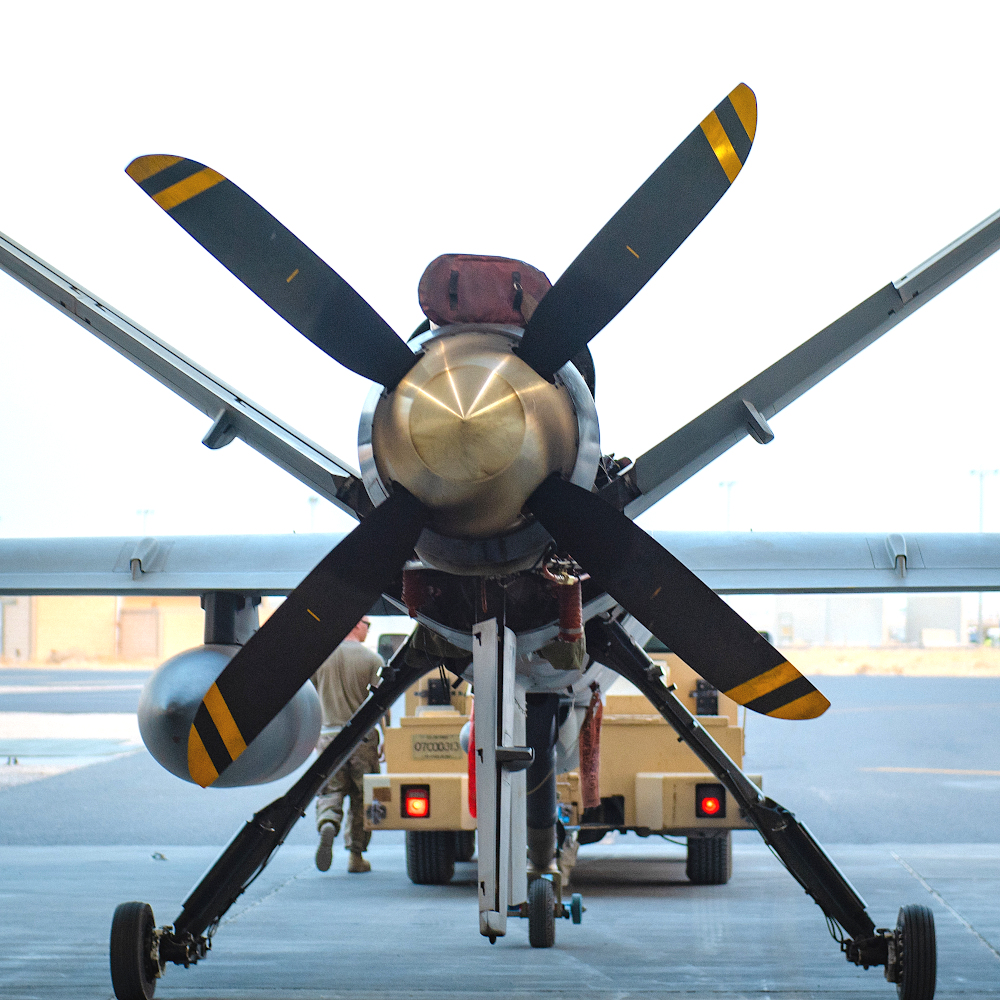
As to who has been flying this small fleet of distinctly configured MQ-9s over Idlib, it is unclear. The AGM-114R9X is, at least at present, understood to be employed exclusively by drones flying in support of JSOC and the CIA. There are also strong indications that there may be some form of overlap in the ownership and operational control of JSOC and CIA drones with regular U.S. Air Force units.
Depending on the exact circumstances of the reporter Reaper losses over Idlib today, it remains to be seen whether this may have an impact on future MQ-9 operations in that part of Syria, no matter who specifically is flying these drones. If a hostile act was involved in the downing of these drones, or drone, it could underscore the limitations of operating non-stealthy drones in any sort of contested environment.
The targeting of Al-Uzbeki, the Al Qaeda in Syria trainer, already came as senior U.S. officials had highlighted a desire to continue withdrawing from eastern Syria, but had also raised concerns about persistent terrorist activity in the western portion of the country. At present, there are approximately 500 U.S. troops still in Syria, primarily in the northeastern corner of the country, as well as a garrison near the Iraqi and Jordanian borders further south.
“Generally, west of the Euphrates River, conditions are much worse [than in the East],” U.S. Marine Corps General Frank McKenzie, the present head of U.S. Central Command, said on Aug. 12 at a virtual event the United States Institute of Peace (USIP) hosted, specifically referring to ISIS. Of course, Al-Uzbeki’s death also underscored how Al Qaeda’s franchise in Syria is also exploiting insecurity in western Syria to further its own aims.
“I don’t think we’re going to be in Syria forever,” McKenzie added. “At some point, we do want to get smaller there. I just don’t know when that’s going to be. As long as we remain, we’re going to work very hard to finish off ISIS.”
Of course, even if the U.S.-led coalition were to withdraw entirely from Syria, it’s very possible, if not probable that JSOC and the CIA would continue their own activities in the country, including targeted strikes against specific terrorists in Idlib, using Reapers.
Contact the author: joe@thedrive.com
